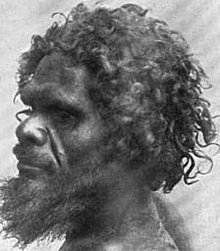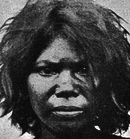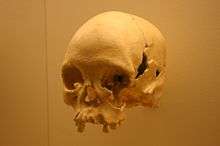Australoid race

The Australoid race is a broad racial classification used to refer to people indigenous to Southeast Asia, South Asia, Australia, Melanesia and historically parts of East Asia. The concept originated with a typological method of racial classification.[1][2][3] They were described as having dark skin with wavy hair, in the case of the Veddoid race of South Asia (including the eponymous Vedda people indigenous to Sri Lanka) and Aboriginal Australians, or hair ranging from straight to kinky in the case of the Melanesian group.
According to this typology, Australoid peoples often mixed with other races (mostly Caucasoid, Mongoloid and Negroid) range throughout Indonesia, the Philippines, Malaysia, Singapore, Thailand, Myanmar, Laos, Cambodia, East Timor, Brunei, Sri Lanka, the Indian subcontinent, Australia, Melanesia, and historically in Japan.
In the Out of Africa theory, the ancestors of the Australoids, the Proto-Australoids, are thought to have been the first branch off from the Proto-Capoids to migrate from Africa about 60,000 BCE. This migration is hypothesized to have taken place along the now submerged continental shelf of the northern shore of the Indian Ocean, reaching Australia about 50,000 BCE. However, the suggested Proto-Australoid–Proto-Capoid link has been contested.
History

In the late nineteenth century, anthropometric studies led to a proposition of racial groups, one of which was termed "Australioid" by Thomas Huxley in an essay 'On the Geographical Distribution of the Chief Modifications of Mankind' (1870), in which he divided humanity into four principal groups (Xanthochroic, Mongoloid, Negroid, and Australioid).[4]
Huxley also concluded that the Melanochroi (Peoples of the Mediterranean race) are of a mixture of the Xanthochroi (northern Europeans) and Australioids.[5] Later writers dropped the first "i" in Australioid, establishing Australoid as the standard spelling.
According to the Archaeologist Peter Bellwood, "many of the present Southern Mongoloid populations of Indonesia and Malaysia also have a high degree of Australo-Melanesian genetic heritage."[6]
Distribution

Huxley's original model included the native inhabitants of South Asia under the Australoid category. The American Journal of Physical Anthropology (1996, p. 382) by American Association of Physical Anthropologists. L. L. (Luigi Luca) Cavalli-Sforza, Paolo Menozzi and Alberto Piazza in their text, The History and Geography of Human Genes (1994, P. 241) both use the term. Balgir (2004)[7] designates tribes as Australoid or Proto-Australoid according to language family. A 2006 CFSL research article which assessed "3522 individuals belonging to 54 (23 belonging to the Austroasiatic, 18 to Dravidian, 7 to Tibeto-Burman and 24 to Indo-European linguistic groups) endogamous Indian populations, representing all major ethnic, linguistic and geographic groups" for genetic variations to support such classifications found no conclusive evidence. It further summed that "the absence of genetic markers to support the general clustering of population groups based on ethnic, linguistic, geographic or socio-cultural affiliations" undermines the broad groupings based on such affiliations that exist in population genetic studies and forensic databases.[8] Australoid components present through Indian Subcontinent and Southeast Asia is genetically closest to Negrito Andamanese Islanders[9] though still divergent[10] however some Indians also have genetic links with Australian Aborigenes, though mixed with Caucasoid or Mongoloid genes as well.[11]
Physical features
Forensic anthropologist Caroline Wilkenson wrote in 2004 that Australoids have the second largest brow ridges "with moderate to large supraorbital arches".[12] Caucasoids have the largest brow ridges similar in size with "moderate to large supraorbital ridges".[12] Negroids have the third largest brow ridges with an "undulating supraorbital ridge".[12] Mongoloids are "absent browridges", so they have the smallest brow ridges.[12]
Huxley wrote in 1870 that Australoids are usually dolichocephalic;[13] their hair is usually silky, black and wavy;[13] they usually have large, heavy jaws and prognathism;[13] their skin is the color of chocolate and the irises are dark brown or black.[13]
Migration to the Americas hypothesis

Ancient skulls of individuals with Australoid morphologies have been found in the Americas, leading to speculation that peoples with phenotypical similarities to the Proto-Australoids may have been the earliest occupants of the New World.[15][16][17] If this hypothesis is correct, it would mean that some Proto-Australoids continued the Great Coastal Migration beyond Southeast Asia along the continental shelf north in East Asia and across the Bering land bridge, reaching the Americas about 52,000 BCE.
In 2015, two major studies of the DNA of living and ancient people detect in modern Native Americans a trace of DNA related to that of native people from Australia and Melanesia. Australo-Melanesian DNA in some living Native Americans, including those of the Aleutian Islands and the Surui people of Amazonian Brazil. Walter Neves and Mark Hubbe argue that these people descended from an early wave of migration that was separate from the one that gave rise to today’s Native Americans, and drew on a different source population in Asia.[18]
Christy Turner notes that "cranial analyses of some South American crania have suggested that there might have been some early migration of "Australoids."[19] However, Turner argues that cranial morphology suggests sinodonty in all the populations he has studied.
One of the earliest skulls discovered in the Americas by archaeologists is an Upper Paleolithic specimen named the Luzia Woman. According to archaeologist Walter Neves of the University of São Paulo, Luzia's Paleo-Indian predecessors lived in South East Asia for tens of thousands of years, after migrating from Africa, and began arriving in the New World, as early as 15,000 years ago. Some anthropologists have hypothesized that Paleo-Indians migrated along the coast of East Asia and Beringia in small watercraft, before or during the last Ice Age.
Neves' conclusions have been challenged by research done by anthropologists Rolando Gonzalez-Jose, Frank Williams and William Armelagos who have shown in their studies that the cranio-facial variability could just be due to genetic drift and other factors affecting cranio-facial plasticity in Native Americans.[20][21][22]
See also
References
- ↑ O'Neil, Dennis. "Biological Anthropology Terms." 2006. May 13, 2007. Palomar College.
- ↑ http://www.pbs.org/wgbh/nova/first/gill.html Does Race Exist? A proponent's perspective by George W. Gill.
- ↑ Moore, Ruth Evolution (Life Nature Library) New York:1962 Time, Inc. Chapter 8: "The Emergence of Modern Homo sapiens" Page 173 – First page of picture section "Man and His Genes": The Australoid race is identified as one of the five major races of mankind, along with the Mongoloid, Negroid, Caucasoid, and Capoid races (pictures of a person typical of each race are shown)
- ↑ Huxley, Thomas On the Geographical Distribution of the Chief Modifications of Mankind. 1870. August 14, 2006
- ↑ Huxley, Thomas. On the Geographical Distribution of the Chief Modifications of Mankind. 1870. August 14, 2006. <http://aleph0.clarku.edu/huxley/SM3/GeoDis.html>
- ↑ Bellwood, Peter (1985). Prehistory of the Indo-Malaysian Archipelago. Australian National University. p. 92. ISBN 978-1-921313-11-0.
- ↑ Balgir, RS; Dash BP; Murmu, B. (2004). "Blood groups, hemoglobinopathy and G-6-PD deficiency investigations among fifteen major scheduled tribes of Orissa, India". Anthropologist. 6: 69–75.
- ↑ Kashyap, VK; Guha, S.; Sitalaximi, T.; Bindu, G.H.; Hasnain, S.E. & Trivedi, R. (2006). "Genetic structure of Indian populations based on fifteen autosomal microsatellite loci" (PDF). BMC Genetics. 7: 28. doi:10.1186/1471-2156-7-28. PMC 1513393
 . PMID 16707019.
. PMID 16707019. - ↑ http://www.livescience.com/38751-genetic-study-reveals-caste-system-origins.html
- ↑ http://s1.zetaboards.com/anthroscape/topic/4846429/11/
- ↑ http://www.nature.com/news/genomes-link-aboriginal-australians-to-indians-1.12219
- 1 2 3 4 Wilkenson, Caroline. Forensic Facial Reconstruction. Cambridge University Press. 2004. ISBN 0-521-82003-0
- 1 2 3 4 Huxley, T. H. "On the Geographical Distribution of the Chief Modifications of Mankind" (1870) Journal of the Ethnological Society of London
- ↑ Bellwood, Peter. Pre-History of the Indo-malaysian Archipelago. Australian National University:1985. ISBN 978-1-921313-11-0
- ↑ Ancient voyage of discovery, Independent, The (London), Apr 8, 1996 by David Keys
- ↑ Scientific American, Skulls Suggest Differing Stocks for First Americans, December 13, 2005
- ↑ National Geographic, Americas Settled by Two Groups of Early Humans, Study Says, Dec 12, 2005
- ↑ Mysterious link emerges between Native Americans and people half a globe away by Michael Balter published in the "American Association for the Advancement of Science" on July 21, 2015
- ↑ Turner, Christy (2002). "Teeth, Needles, Dogs and Siberia: Bioarchaeological Evidence for the Colonization of the New World". The First Americans: The Pleistocene Colonization of the New World'. University of California Press. p. 138. ISBN 978-0-940228-50-4.
- ↑ Frank L'Engle Williams (2003). "Kennewick and Luzia: Lessons From the European Upper Paleolithic". AMERICAN JOURNAL OF PHYSICAL ANTHROPOLOGY. Retrieved 2008-02-15.
- ↑ Stuart J. Fiedel (2004). "THE KENNEWICK FOLLIES: "New" Theories about the Peopling of the Americas". Retrieved 2008-02-15.
- ↑ Rolando Gonzalez-Jose; Maria Catira Bortolini; Fabrıcio R. Santos & Sandro L. Bonatto (2008). "The Peopling of America: Craniofacial Shape Variation on a Continental Scale and its Interpretation From an Interdisciplinary View". AMERICAN JOURNAL OF PHYSICAL ANTHROPOLOGY. Retrieved 2008-02-15.


